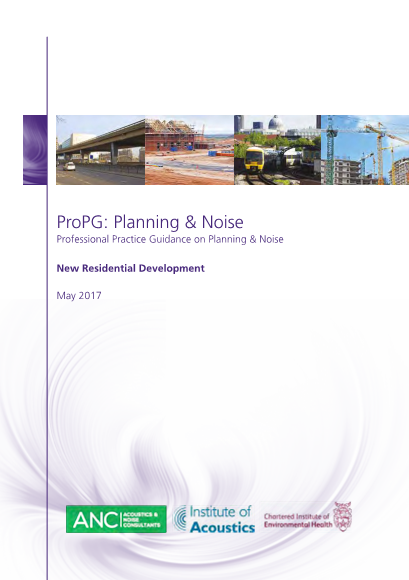Residential Noise Impact Assessments
How to Assess Noise for a Residential Planning Application
Introduction
When planning new residential developments, understanding and mitigating noise impact is crucial to ensure compliance with national planning policies and to provide a comfortable living environment for future residents.
This guide explores the framework set by the National Planning Policy Framework (NPPF), the Noise Policy Statement for England (NPSE), the variability in treatment across local authorities in the UK, and dives into specific methodologies and standards such as ProPG: Planning & Noise, BS 8233, and the newly introduced Building Regulations Approved Document O.
These guidelines and standards collectively inform the approach to noise assessment and mitigation strategies essential for residential planning applications.

Understanding the National Planning Policy Framework (NPPF) on Noise
Legislation – The Town and Country Planning Act 1990
The Town and Country Planning Act 1990 consolidates enactments relating to town and country planning in the UK, excluding special controls on buildings and areas of special architectural or historic interest and hazardous substances. It aims to regulate land use and development, providing a framework for local planning authorities to prepare local plans, decide on planning applications, and enforce planning control. The Act introduces provisions for development plans, development control, enforcement, and appeals. It is amended periodically to reflect changes in planning policy and law, ensuring it remains relevant to contemporary planning needs.
National Policy – National Planning Policy Framework 19 December 2023
The National Planning Policy Framework (NPPF) is a guidance document for local planning authorities and decision-makers in England. It sets out the government’s planning policies and how these are expected to be applied. It complements the Town and Country Planning Act by providing the overarching policy framework that local plans and decisions must reflect, ensuring development is carried out in a sustainable manner. While the Act provides the legal structure for planning in the UK, the NPPF guides the interpretation and application of these laws, aiming to streamline and simplify the planning process.
The Town and Country Planning Act 1990 states that decisions on planning applications should be made in accordance with the development plan unless material considerations indicate otherwise; this includes local and neighbourhood plans that have been brought into force and any spatial development strategies produced by combined authorities or elected Mayors. This principle is foundational in the planning decision-making process in the UK, ensuring that developments are carried out in a way that is consistent with local planning strategies, policies, and objectives as outlined in the development plan. This ensures a degree of predictability and consistency in planning decisions, balancing the need for development with the protection of the environment and local amenities.
The National Planning Policy Framework (NPPF) is based on a range of principles that support sustainable development and effective planning in England. These principles go beyond the legislative foundation provided by the Town and Country Planning Act to encompass a wider array of objectives and policies intended to guide development in a sustainable, efficient, and community-focused manner.
Key principles that the NPPF is based on include:
- Achieving Sustainable Development: This is at the heart of the NPPF, aiming to balance economic, social, and environmental goals.
- Plan-Making and Decision-Making: These processes are designed to be genuinely plan-led, prioritising the development plan documents prepared by local planning authorities.
- Delivering a Sufficient Supply of Homes: Addressing housing needs is a critical aspect, with the NPPF emphasising the need to boost the supply of housing.
- Building a Strong, Competitive Economy: The framework supports economic growth and innovation across different regions.
- Ensuring the Vitality of Town Centres: Encouraging the development and prosperity of town centres.
- Promoting Healthy and Safe Communities: The NPPF aims to create social environments where communities can thrive.
- Conserving and Enhancing the Natural and Historic Environment: Protecting landscapes, biodiversity, and heritage assets is a key objective.
- Meeting the Challenge of Climate Change: The framework integrates considerations of climate change mitigation and adaptation into planning.
- These principles reflect a comprehensive approach to planning, aiming to ensure that development is sustainable, benefits communities, respects the environment, and supports the economy.
The NPPF was created as part of a broader reform effort to consolidate existing planning policies into a clearer, more accessible framework. It succeeded in reducing the volume of national policy guidance significantly, from over 1,300 pages to a concise document that guides planning decisions across England. This consolidation was aimed at making the planning system more understandable and transparent, facilitating better decision-making that reflects local needs while adhering to national priorities.
The framework also emphasizes the importance of local plans being up to date and aligning with the strategic priorities set out in the NPPF. Where local plans are absent, silent, or outdated, the NPPF guides that permission should generally be granted for development proposals, unless significant and demonstrable reasons suggest otherwise. This highlights the critical role of local planning authorities in preparing and maintaining current local plans that reflect the framework’s principles and objectives.
The NPPF states that the “purpose of the planning system is to contribute to the achievement of sustainable development” and refers to the UN member agreement to “pursue the 17 Global Goals for Sustainable Development in the period to 2030”.
On this basis, the NPPF sets out three overarching objectives as follows:
- an economic objective – to help build a strong, responsive and competitive economy, by ensuring that sufficient land of the right types is available in the right places and at the right time to support growth, innovation and improved productivity; and by identifying and coordinating the provision of infrastructure
- a social objective – to support strong, vibrant and healthy communities, by ensuring that a sufficient number and range of homes can be provided to meet the needs of present and future generations; and by fostering well-designed beautiful and safe places, with accessible services and open spaces that reflect current and future needs and support communities’ health, social and cultural well-being; and
- an environmental objective – to protect and enhance our natural, built and historic environment; including making effective use of land, improving biodiversity, using natural resources prudently, minimising waste and pollution, and mitigating and adapting to climate change, including moving to a low carbon economy.
Paragraph 96 states that “planning policies and decisions should aim to achieve healthy, inclusive and safe places”.
Paragraph 135 states that “planning policies and decisions should ensure that developments… “create places that are safe, inclusive and accessible and which promote health and well-being, with a high standard of amenity for existing and future users”.
Paragraph 180 states that “planning policies and decisions should contribute to and enhance the natural and local environment by… preventing new and existing development from contributing to, being put at unacceptable risk from, or being adversely affected by, unacceptable levels of soil, air, water or noise pollution or land instability. Development should, wherever possible, help to improve local environmental conditions such as air and water quality, taking into account relevant information such as river basin management plans.
Paragraph 191 states that “planning policies and decisions should also ensure that new development is appropriate for its location taking into account the likely effects (including cumulative effects) of pollution on health, living conditions and the natural environment, as well as the potential sensitivity of the site or the wider area to impacts that could arise from the development. In doing so they should:
- mitigate and reduce to a minimum potential adverse impacts resulting from noise from new development – and avoid noise giving rise to significant adverse impacts on health and the quality of life.
- identify and protect tranquil areas which have remained relatively undisturbed by noise and are prized for their recreational and amenity value for this reason.”
At this point the NPPF refers to the separate Noise Policy Statement for England Explanatory Note.
An important note should also be made of paragraph 193, which states that “planning policies and decisions should ensure that new development can be integrated effectively with existing businesses and community facilities (such as places of worship, pubs, music venues and sports clubs). Existing businesses and facilities should not have unreasonable restrictions placed on them as a result of development permitted after they were established. Where the operation of an existing business or community facility could have a significant adverse effect on new development (including changes of use) in its vicinity, the applicant (or ‘agent of change’) should be required to provide suitable mitigation before the development has been completed.”
The Noise Policy Statement for England (NPSE) is an essential document for managing noise within the context of sustainable development, aiming to balance the inevitable noise from a vibrant society with the need to protect individuals’ quality of life and health. It acknowledges that while noise can be a positive aspect of city life for some, for others, it’s an unwanted intrusion affecting their well-being.
The NPSE has evolved from historical legislation and reports, such as the Noise Abatement Act of 1960 and the Wilson report of 1963, to address changing noise sources, types, and public attitudes towards noise. It aims to separate noise sources from sensitive receivers and minimise noise “as far as reasonably practical,” incorporating concepts like the “best practicable means” from the Environmental Protection Act 1990 for noise management.
There are three aims in the Noise Policy Statement for England as follows:
- Avoid significant adverse impacts on health and quality of life from environmental, neighbour and neighbourhood noise within the context of Government policy on sustainable development.
- Mitigate and minimise adverse impacts on health and quality of life from environmental, neighbour and neighbourhood noise within the context of Government policy on sustainable development.
- Where possible, contribute to the improvement of health and quality of life through the effective management and control of environmental, neighbour and neighbourhood noise within the context of Government policy on sustainable development.
A noise impact assessment should demonstrate that the aims of the NPSE are achieved. This should be done for every aspect of noise that has the potential to result in adverse health impacts as a result of the proposed development; these are most typically as follows:
- Traffic noise impact on the proposed development (road, rail, air).
- Plant or other industrial/commercial noise impact on the proposed development.
- Noise impact of the proposed development on the surrounding area (typically plant noise or similar).
- Noise impact from one part of the proposed development on the other (typically from non-residential to residential uses).
- Noise impact on the surrounding area due to an increase in traffic travelling to or from the proposed development.
- Construction noise impact as the proposed development is being erected.
For residential developments, the noise impact assessment typically focuses on the traffic noise impact on the proposed development.
For each of these potential adverse health impacts, the acoustic consultant should determine appropriate noise criteria, and where necessary, establish the NOEL, LOAEL, and SOAEL:
- NOEL (No Observed Effect Level): The threshold below which noise has no detectable impact on health or quality of life.
- LOAEL (Lowest Observed Adverse Effect Level): The minimum level at which adverse effects from noise on health and quality of life start to be observed.
- SOAEL (Significant Observed Adverse Effect Level): The point above which noise leads to significant adverse impacts on health and quality of life.
To demonstrate that the aims of the NPSE are achieved, the noise impact assessment simply needs to demonstrate that no exceedances of the relevant SOAELs occur, and that any impacts that are above the LOAEL have been mitigated and minimised as far as is practicable.





Local Policy
Local authorities integrate the principles from the Town and Country Planning Act, the National Planning Policy Framework (NPPF), and the Noise Policy Statement for England (NPSE) into their Local Plans and Development Plans by ensuring that planning policies and decisions promote sustainable development, consider environmental impacts like noise, and adhere to national guidelines. These frameworks guide local planning authorities in balancing development needs with environmental protection and community well-being, requiring considerations of noise impact, housing supply, economic growth, and environmental conservation from the outset of the planning process. This integrated approach ensures that development is strategically planned to minimize adverse impacts and promote healthy, sustainable communities.
Many local authorities go beyond national guidelines by providing supplementary guidance on noise impacts to address specific local needs and contexts. This additional guidance helps developers, planners, and the community understand the expectations and standards for managing noise in new developments, renovations, and other planning applications. By tailoring their guidance to local circumstances, these authorities ensure more effective noise management and mitigation strategies that contribute to the overall quality of life and sustainability of their communities.
The acoustic consultant should always review Local Plans, Development Plans and Supplementary Planning Guidelines to establish the relevant aims, goals and policies that are relevant to the local area. The consultant should also, where necessary and appropriate, consultant with the Environmental Health Department of the local authority to confirm their approach to the assessment as well as the criteria they are using to define the NOELs, LOAELs, and SOAELs.
The ProPG: Planning & Noise Professional Practice Guidance, developed collaboratively by the Association of Noise Consultants (ANC), Institute of Acoustics (IOA), and Chartered Institute of Environmental Health (CIEH), offers a framework for managing noise within the planning system in England. This guidance emphasizes the importance of good acoustic design in new residential developments to protect residents from harmful effects of noise. It outlines a recommended approach that includes initial risk assessment, consideration of acoustic design, internal and external noise level guidelines, and assessment of other relevant issues. The guidance aims for a consistent approach to noise management in planning applications, promoting sustainable development by incorporating effective noise mitigation and management strategies early in the planning process.
At Hedya, we always apply the principles and methods promoted in ProPG to ensure that good acoustic design is applied throughout our residential developments.
Noise Survey Methodology
A residential noise impact assessment requires a noise survey to be undertaken to establish the baseline conditions upon which the subsequent noise modelling and/or assessment can be undertaken.
The survey should typically be conducted in accordance with BS 7445-1:2003 Description and measurement of environmental noise. BS 7445-1:2003 provides guidelines for describing and measuring environmental noise, defining key quantities and procedures. It focuses on measuring noise in community environments, using the equivalent continuous A-weighted sound pressure level as a fundamental quantity. The standard outlines proper instrumentation (preferring type 1 sound level meters in accordance with BS EN 61672), calibration, measurement positions (outdoor, near buildings, inside buildings), and considers meteorological effects. It details methods for measuring fluctuating, steady, and event-specific noises, and emphasizes the importance of recording measurement techniques, conditions, and qualitative data for accurate assessment and compliance.
An acoustic consultant preparing for a noise survey will initially consult with the client and local authority to understand the project scope and regulatory requirements. They will determine the survey’s objectives, identify sensitive receptors, and select appropriate measurement locations to capture representative noise levels. Coordination with the local authority ensures methods align with regulations. Establishing measurement positions involves considering source-receptor paths, environmental factors, and potential obstructions. A risk assessment is conducted to identify hazards related to the survey location and equipment, with measures put in place to mitigate risks. This preparatory phase is crucial for ensuring the survey’s effectiveness and compliance.

ProPG Noise Impact Assessment
The four key elements to be undertaken in parallel during Stage 2 of the recommended approach are summarised below.
Element 1 – demonstrating a “Good Acoustic Design Process”
It is essential that any noise impact assessment demonstrates that the following design aspects have been considered, and explains to the Local Authority how good acoustic design has been incorporated where possible:
- Check the feasibility of relocating, or reducing noise levels from relevant sources.
- Consider options for planning the site or building layout.
- Consider the orientation of proposed building(s).
- Select construction types and methods for meeting building performance requirements.
- Examine the effects of noise control measures on ventilation, fire regulation, health and safety, cost, CDM (construction, design and management) etc.
- Assess the viability of alternative solutions.
- Assess external amenity area noise.
This is a demonstration that the second aim of the NPSE has been achieved, by designing to minimise and mitigate adverse noise impacts.
Element 2 – observing internal “Noise Level Guidelines”
Based on the analysis of the noise survey undertaken, we would establish the expected external noise level at each of the proposed external facades. This may be done directly from the measurements at a proposed façade location, or may be derived from the measurements through calculations in accordance with ISO 9613-2:2024. These calculations may be carried out be hand or through the creation of a noise model on software such as CadnaA or SoundPlan.
We would demonstrate, through calculations undertaken in accordance with BS 8233 and/or BS EN 12354-3 that suitable internal ambient noise levels are achievable through the specification of appropriate building envelope constructions and ventilation strategies. Suitable internal ambient noise levels can differ depending on the source of noise and the context, however for steady state noise such as road traffic, suitable maximums for internal noise are provided in BS 8233 as follows:

It is necessary to advise on the windows that will need to be closed during the night time period to achieve compliance with Building Regulations Approved Document O (ADO, overheating). ADO states that bedroom windows are likely to be closed during sleeping hours if noise within bedrooms exceeds 40 dB LAeq,T when averaged of the 8-hour night-time period, or where the maximum noise level exceeds 55 dB LAFmax more than 10 times per night. Where windows are required to be closed, it is important that this information is provided to the building services/energy consultants as they will need to account for this when undertaking the overheating assessment for the proposed development. Achieving compliance with ADO could mean changes to the façade proposals to provide oversized acoustic ventilators, or the addition of cooling to the scheme, both of which can have a large impact on cost and planning if not properly considered at this early stage.
We will advise on windows that we would recommend be closed during the daytime summertime ventilation condition in accordance the Acoustics, Ventilation and Overheating guidance.
Element 3 – undertaking an “External Amenity Area Noise Assessment”
Based on the analysis of the noise survey undertaken, we would establish the expected external noise level at each of the proposed external amenity spaces and advise on suitability. Where noise levels exceed the relevant guideline levels we would advise on how these adverse impacts might be offset by the presence of other nearby protected external amenity spaces (public or private).
Element 4 – consideration of “Other Relevant Issues”.
This section comprises the following aspects:
- Compliance with relevant national and local policy
- Magnitude and extent of compliance with ProPG
- Likely occupants of the development
- Acoustic design v unintended adverse consequences
- Acoustic design v wider planning objectives
Key considerations in this section typically include:
- Consideration of Local Plan policies
- Consideration of new sources of external plant noise in accordance with BS 4142:2014.
- Consideration of the noise impact from proposed non-residential to residential development where applicable.
The noise impact assessment is written up in a technical report which is suitable for submission to the local planning authority in support of a planning application. The report, where undertaken in accordance with the above procedure, will demonstrate that a good acoustic design process has been followed in the design of the proposed development, and that it will achieve the aims and requirements of local, regional and national planning policy and legislation.
Talk to us
Contact Heyda today for a specialised consultation. Together, let’s apply good acoustic design to your residential developments. Reach out to us to find out more.

